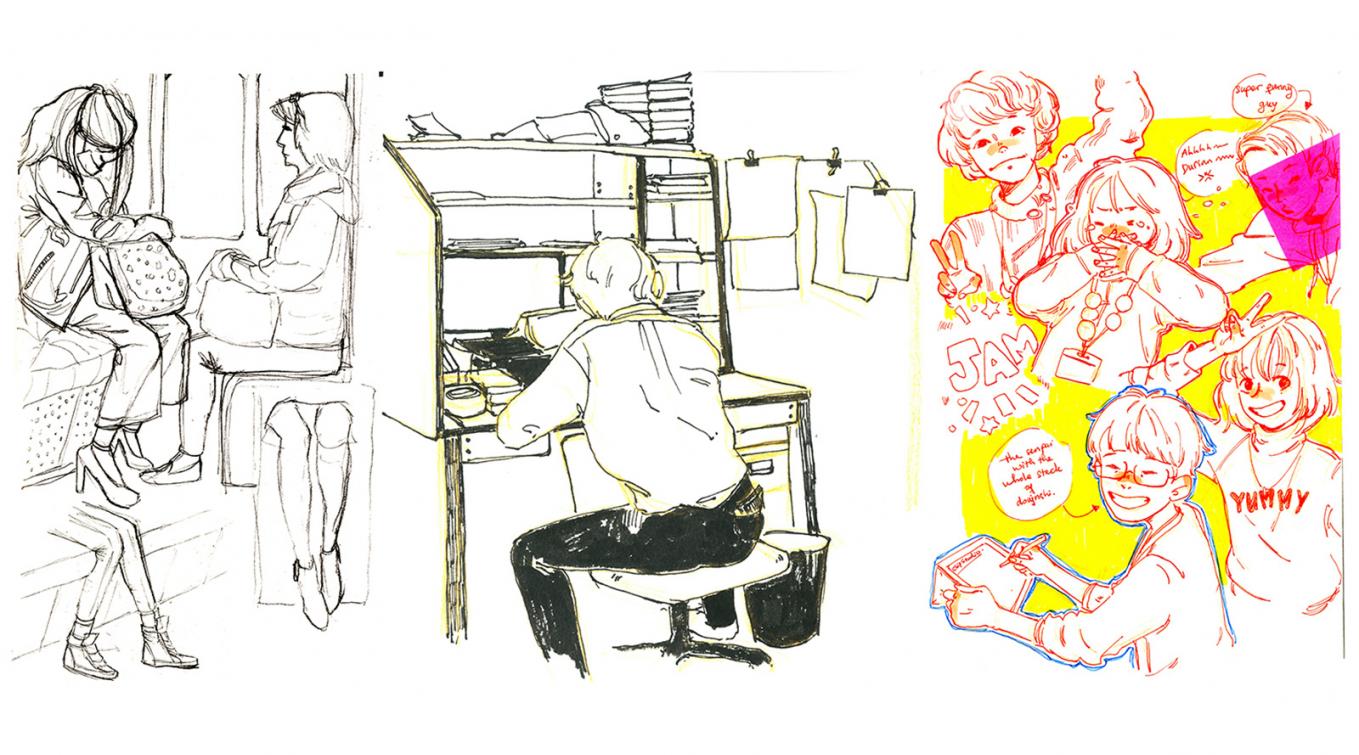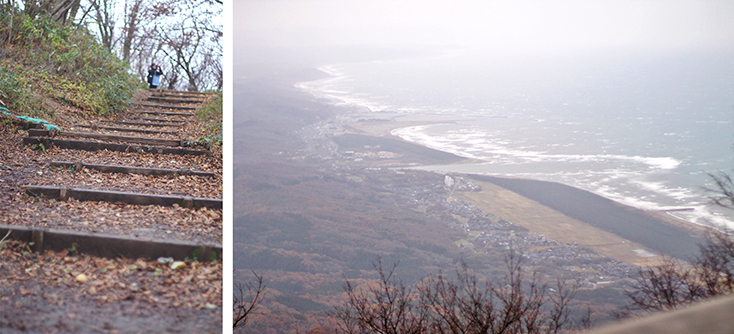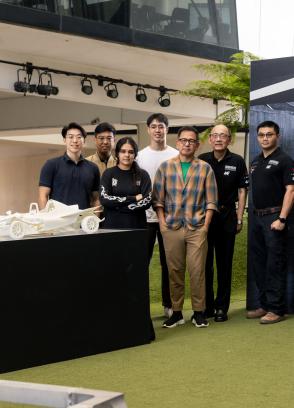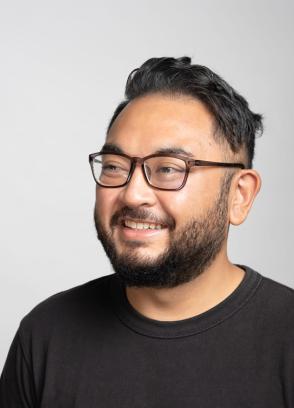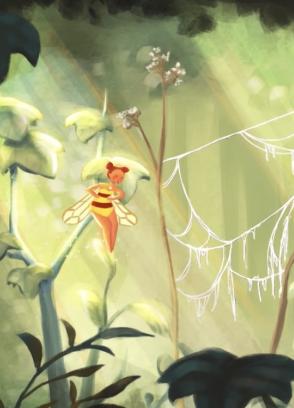15 March 2018
Animation students, like any other young people in education, rely on books to learn. Art books from major animation studios, such as Disney and Pixar, provide a wealth of reference materials, such as rough-cut sketches, conceptual artworks, experimental rendering of environments, character designs and storyboards. However, the production of such detailed art books is not common practice in the Japanese animation industry, as our BA(Hons) Animation Art students realised during an exchange trip with Niigata University.
According to final year student, Christabel Mervyn, “Like any other industry, anime is similarly driven by the commercial market and its profits. One aspect that became very apparent to us during our visits was that pre-production and production materials are often disposed of or shelved in obsolete locations when projects are completed. I find this to be such a pity because there is a wealth of information within these developmental stages that students can learn from.”
Akihabara district, where anime and manga culture in Japan flourish. Image credit to IQRemix and Alexander Svensson respectively, under CC BY 2.0.
In an annual report published by The Association of Japanese Animation, the anime industry maintained its positive growth for six years running, and even hit a record high of generating 1.8 billion yen (S$22.4 billion) in 2015, a 12% increase from 2014. Without a doubt, animation (or ‘anime’, as it has come to be referred as a wholly Japanese product) is a booming business in Japan, and from an anthropological standpoint, it is a cultural and material artefact of undeniable importance.
Niigata University understood this, and thus established the Archive Centre for Anime Studies (ACASiN). They remain the first and only national university in Japan with an anime archival centre. Adopting an ecological approach, ACASiN works with production studios and media companies to acquire, catalogue, preserve and digitise developmental anime materials in order to safeguard crucial moments in anime history, and enable academics and students to conduct research.
As a College that prides itself in providing a critical arts education, LASALLE is honoured to sign a three-year Memorandum of Understanding (MOU) with Niigata University on 14 March 2018. The exchange trip between the two institutions was part of this MOU, and our BA(Hons) Animation Art students got the chance to attend seminars with local students and visit ACASiN.
Concept sketches by Gainax for Royal Space Force: The Wings of Honnêamise (1987).
Student Sally Teo shared, “We were able to study in detail original 1980s hand-drawn works from key figures in animation like Director Hideo Watanabe and Director Hiroyuki Yamaga. By analysing the quality of their drawings, the line work done, the shading techniques used, our visual library expands and this aids us in bettering our own work.”
Other than simply observing the art done by Director Yamaga, who is co-founder of pioneering animation studio Gainax, our students also had the opportunity to meet and interact with the man himself. In a spontaneous excursion requested by Director Yamaga, they roused to a freezing, raining and blistering morning to hike up Yahiko Mountain. Bleary-eyed, with only their coats to shield them from the elements, the group trudged upwards, determined to scale the 634-metre beast. Though only two students managed to reach the peak, the excursion left all reeling and it was unanimously selected as the most memorable experience on the exchange trip. When queried on why he picked that morning specifically for this hike, Director Yamaga replied, “Such a day is better than a beautiful day. The cold and wet will remain stuck in your minds, and will leave a very strong mental image.”
[Left]: The steep incline up Yahiko Mountain. [Right]: The view from the top of Yahiko Mountain.
This was precisely what was called upon in a workshop the students attended the very next day. Director Yamaga remarked that while our students were very talented, “Their drawing reflects their structured bonds, so they need to cast these bonds aside.” This harks back to a belief Director Yamaga developed when he was young, and continues to hold to this day, which is that anime is “a locus of expression designed for young people.” In an exercise meant to tap into the unexplored fountain of creativity within our students, Director Yamaga asked them to recall their hiking experience and to use it as a base to create their own fictional world, no matter how wacky.
Months after this session, student Xinlong Tan reflected, “By taking away all the rules, Yamaga-sensei was trying to teach us that world-building within animation was of utmost importance as this was ultimately what the story and characters revolve around. Our personal experiences and imagination are therefore good starting points to begin thinking about this world that our characters reside in.”
Concurring, student Jamie Tran even admitted, “We learnt a lot about ourselves and our work. We actually spent the whole of December agonising over our art, going through this mental block where we were all stuck with our art direction and style. I just couldn’t seem to draw anything that I felt happy with. I guess it’s because even though we’ve gotten better in our thinking, our skill hasn’t matched up yet so it’ll take a lot of practice to fill this gap.”
Sketches done by Xinlong, Christabel and Jamie respectively during their trip, featuring moments in the subway, a staff at Toei Animation working, and the many new friends made at the Japanese Animation & Manga College (JAM).
The insights they gained did not stop there. Their exchange trip was made even more fruitful with visits to distinguished animation studios such as I.G Production, Toei Animation and TMS Studio. Accustomed to drawing straight into a digital interface via a stylus and tablet set, Christabel, Sally, Xinlong and Jamie were amazed that Japanese animators still drew with the pencil and paper medium, before scanning these into the software to begin re-lining. Another noted difference in production process was that Japanese animation operated on a slower frame rate, with each image holding for three seconds, as opposed to two which is the practice at LASALLE and in the West.
A demonstration of compositing, the act of combining separate visual elements into a single frame, at TMS Studio.
“It was a thoroughly eye-opening experience to step foot into these studios that have produced countless popular series such as Ghost in the Shell, Lupin and One Piece, and to meet the directors and producers in person to understand their workflow,” Sally said.
With all they have gleaned, the students got back to Singapore and busy prepared themselves for a group exhibition. Beyond serving as a platform to consolidate their key takeaways from the trip, A World is Born: Emerging Arts and Designs in 1980s Japanese Animation also seeks to prove the value in archiving. Thanks to the work ACASiN has done, rare concept arts from Gainax’s cinematic debut, Royal Space Force: The Wings of Honnêamise (1987), will be showcased in Singapore for the very first time.
When asked for his thoughts on being part of this large project that is dedicated to archival methods and production systems of animation, Xinlong commented, “Few of us stop to think about the nature of animation and our personal reasons behind why we want to create animation. However, when we look back at what animators sought to achieve then, we are floored by their enthusiasm and creativity to simply want to produce a work that speaks to people. This has deeply inspired me. Access to such historical and developmental materials are crucial for students to learn, and I’m grateful to be given the opportunity to be a part of this.”
Odyssey (2018). A series of illustrations based off different experiences in Japan, that will be on exhibition as part of A World is Born. This is a collective collaboration between, from left to right, Christabel, Jamie and their classmates Cheryl, Natalie and Aysha.
As young students, eager to better their artistry and prove themselves, not so much to the world but more so to the high standards with which they hold themselves to, Christabel, Sally, Xinlong and Jamie are constantly practising. Entering their classroom, one finds them all huddled at their desks, eyes barely lifting from the illustration they are working on, completely oblivious to the world outside the one they are currently creating.
It sounds all-consuming, but that is the level of concentration and dedication with which they are pursuing their craft. Hearing them speak and watching them work, it becomes apparent that all four find intrinsic joy in drawing and animation art. As clearly articulated by Christabel, “To get our idea across to a kid, on even a simple notion such as how a ball moves from point A to B, we have to put some thought on how we can give the animation a sense of clarity. Bringing a flat image to life takes a long time to study, but when the audience gets your idea, when they understand your vision, there is a sense of connection with them and it’s a pretty good feeling.”
[Left]: Cold (2018). A still of an animation, done by Xinlong. depicting the cold he felt during the trip. [Middle & Right]: Ramen Theatre Show (2018). An interactive mini-theatre device made by Sally that transports individuals to a cosy ramen store upon looking through the peephole. She was inspired by the group’s trip to the Karakuri Museum where this large theatre device (extreme right) operated like a clockwork to tell a story. Both works will also be on showcase at A World is Born.

